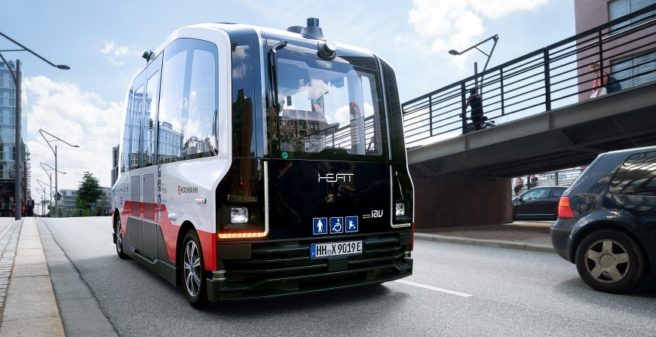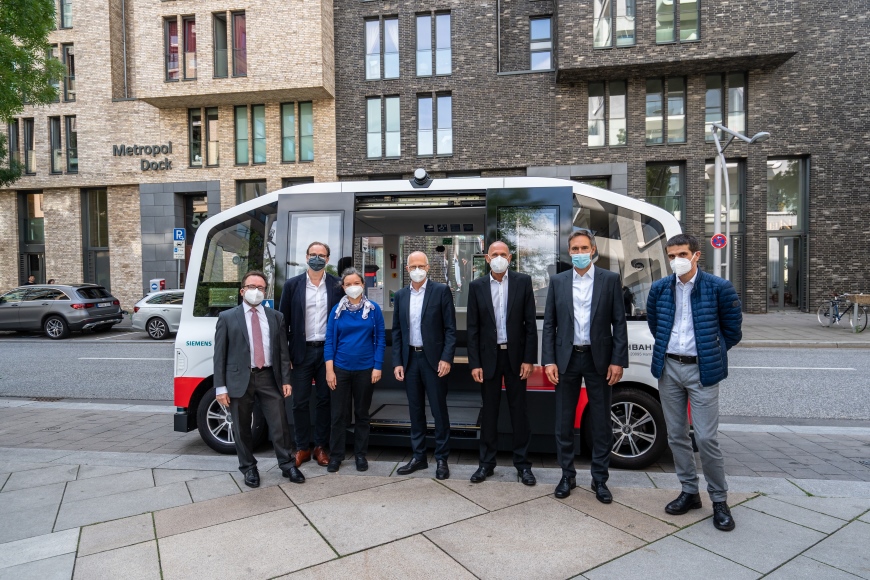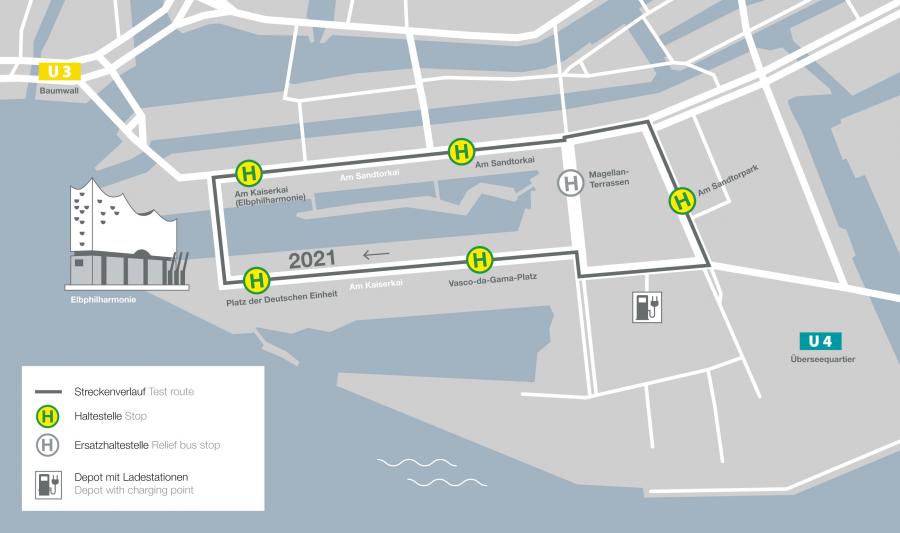
Two months before experts from around the world arrive in Hamburg to explore the future of mobility at the ITS World Congress, residents of Hamburg can get a personal taste of it beginning today. The self-driving minibus of the HEAT (Hamburg Electric Autonomous Transportation) project inaugurated public service in HafenCity today in the presence of Hamburg Mayor Dr. Peter Tschentscher.
Dr. Peter Tschentscher, Mayor of the Free and Hanseatic City of Hamburg:
“By integrating a new technology for autonomous driving into Hamburg’s road traffic, HEAT is providing a strong stimulus for the development of future mobility. Comfortable, convenient and climate-friendly local public transport should be available throughout the city in the future as a viable alternative to using private cars. At the same time, the HEAT project also offers the city a preview of the ITS World Congress being held this October. At the event, Hamburg will show mobility concepts for the future, including autonomous driving in actual operation, intelligent and networked traffic management for both road and rail, and digital services that make our mobility easier, more comfortable and more convenient. I thank the initiators of the HEAT project and wish them safe and successful operations.”

Those interested can ride the minibus on its nearly two-kilometer circuit with five stops until the congress opens in mid-October. The vehicle operates on a route from the Sandtorkai via the Sandtorpark and Kaiserkai along the Elbphilharmonie concert hall at a speed of up to 25 km/h.
Dr. Anjes Tjarks, Senator for Transport and Mobility Transition:
“The expanded approval for passenger service on the entire route along the Elbphilharmonie marks a further milestone for the mobility of tomorrow. The residents of Hamburg can now personally experience autonomous driving in an electric bus for a total of two kilometers in a major urban environment. This neatly demonstrates what electrically powered, autonomous-driving minibuses could contribute to both inner-city districts and suburban areas in the future to transport people safely, comfortably, and emission-free to their destinations and connect them with the existing rapid transit network. This form of transport is unique worldwide and highlights Hamburg’s pioneering role in Germany in the field of digital, sustainable mobility concepts.”
Despite the many challenges presented by the pandemic, the HEAT project achieved all of its key goals well in advance of the ITS World Congress. The primary objective of the research and development project is to find out whether autonomous minibuses are suitable and accepted for urban transport by the public. The research project will now be wrapped up with practical everyday tests with passengers.
Henrik Falk, CEO of HOCHBAHN:
“HEAT marks the first research project in Germany in which an autonomous bus operates under real traffic conditions through a control center in the middle of a Germany city. All Hamburg residents are invited to join us and personally experience the mobility of the future.”
The autonomously operating minibus was developed by IAV, has three seats and standing room for four, and is equipped with a ramp for barrier-free entries and exits. Due to the pandemic-related hygiene regulations currently in effect, capacity is limited to three persons at the same time. The only requirement for riding is a prior registration per app and wearing a standard medical mask.

Matthias Kratzsch, Chairman of the Managing Board, IAV GmbH:
“ The HEAT concept enables us to safely operate a fully automated shuttle for local public transport in the HafenCity of Hamburg. HEAT demonstrates what the sustainable, user-oriented mobility of tomorrow could look like – a future that IAV, as a provider of high-tech solutions, is playing a key role in shaping.”
The vehicle’s direct observation and assessment of its surroundings is based on a system of radar and lidar sensors supported by cameras. The minibus also relies on the new route infrastructure developed by Siemens Mobility and installed by Hamburg Verkehrsanlagen (HHVA). In addition, it uses a high-resolution map of its current route, accurate down to a few centimeters, provided by the city of Hamburg. The shuttle processes information from the map to precisely determine its position after comparing it with data from its momentary surroundings. Thanks to this continual merging and processing of data from multiple sources, the autonomous minibus can, among other things, automatically turn left, drive around obstacles in its path, and operate at speeds up to 25 km/h, fitting in perfectly with flowing traffic in HafenCity.
Manfred Fuhg, Vice President Sales Rail Infrastructure Germany, Siemens Mobility:
“We can achieve the necessary transition to ecofriendly transportation in cities, switching from individual transport to local public transport, only by intelligently linking various forms of mobility. Autonomous shuttles can play an essential role as a new and attractive form of mobility. To provide them, we need to have intelligent transport systems. HEAT demonstrates how linking infrastructure and vehicle data contributes to the reliability of such a system. Siemens Mobility will use the findings from the HEAT project to further refine and advance our vision of autonomous public transport solutions for cities.”
The use of roadside infrastructure is a unique feature of HEAT compared to other projects with autonomous vehicles. This infrastructure provides additional data along the route about other vehicles, bicycles and pedestrians outside the sensor range of the minibus. This expanded observation and intelligent assessment of the vehicle’s extended surroundings has a direct impact on road safety. Communication between the vehicle and the surrounding infrastructure also enables the minibus to pass traffic lights without any intervention by the vehicle attendant. Thanks to the constant interaction of all system components, the minibus can independently view and assess an entire intersection, including other approaching vehicles, pedestrians, or bicycles, and automatically stop and resume turning as the situation allows.
With the beginning of live passenger service, user-focused research at DLR is also entering a decisive phase. As was done during the project’s first trial run, passengers will be asked directly about their riding experience. Compared to the passenger trials undertaken in the past year, the length of the route and number of stops are now finalized. In addition, the hours of passenger service are longer, giving even more people than last year an opportunity to ride the minibus and describe their experiences. An evaluation of activities in the control center is also included in the project’s research.

Prof. Dr. Michael Ortgiese, Deputy Scientific Director, DLR – Institute for Transport Systems Technology: “Our research focuses on people and their needs and requirements with regard to new mobility systems. On the one hand are the users: We want to know about their experience with autonomous vehicles and what they need to feel comfortable. Based on this information, we can develop technical solutions for user-oriented driverless operations. On the other hand, HEAT also offers us an excellent opportunity to investigate how the use of self-driving vehicles in public transport affects activities in the control center and what this means for designing future control center workplaces.”
One of the biggest challenges in the research project remains developing a legal framework for allowing autonomous vehicle operations. It was only in May of this year that Germany’s Federal Council finally approved a legal resolution that permits autonomous vehicles to operate without drivers in specifically defined public road space. However, this decision came too late for the HEAT project, and as a result, a vehicle attendant must remain on board to ensure safety until the ITS World Congress.
Matthias Hartwig, IKEM:
“HEAT shows the possibilities and limitations of the existing legal framework when it comes to implementing innovative mobility concepts. With its holistic approach, the HEAT project provides important impulses for developing new legislative proposals for autonomous operations.”
The current operating hours of the autonomous minibus can be checked at www.hochbahn.de/heat .
We published further information on the HEAT project here:

